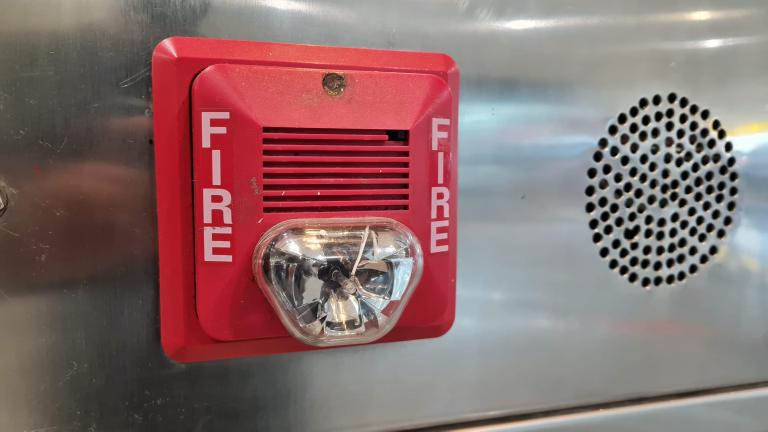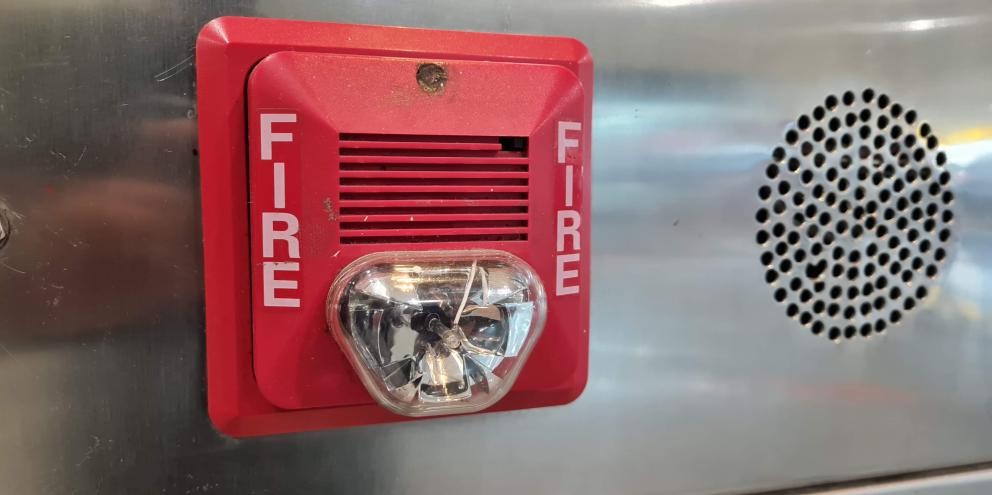
Surgical fire is considered so rare a complication, it’s often called a “never event.1” However, considering the fact that the incidence of these fires is estimated to be approximately 600 per year in the United States alone, that “never event” classification is questionable at best1. Additionally, for patients who experience the potentially devastating complications of these events, their rarity offers little comfort.
These fires, which occur either on the patient’s skin or in the patients themselves, such as in their respiratory tract or trachea, can lead to life-threatening burns and other injuries1. Nowhere, are these fires and their complications more prevalent than in ENT surgery, where a heat source is far more likely to come into contact with a fuel (oxygen), which can ignite a fire like a blowtorch, causing potentially severe damage to the airway and lungs1,3.
Because of this, a thorough understanding of the fire triangle and monitoring of both inspired and expired oxygen are vital to increasing patient safety and reducing the number of adverse outcomes for patients undergoing ENT surgery.
In this article, we’ll discuss the fire triangle as it applies to airway fires and why expired oxygen should not be overlooked in their prevention. We’ll also take a look at additional factors that must be considered to improve fire prevention during procedures that take place in or near the airway.
Visualizing the fire triangle
Only three factors must be present to ignite a fire. Known as the fire triangle, these include an oxidizer, a heat source and a fuel1,2.
In the case of surgical fires, oxygen plays the key role. No oxygen means there is no oxidizer present to accelerate and feed the fire. In fact, at 100% oxygen concentration, even inert fuels, such as dust particles, may undergo auto-ignition due to simple friction1.
Heat or ignition sources may include cautery devices or laser energy2. According to a systematic review by Kezzi, I et al., electrocautery served as the ignition source in 90% of surgical fires1.
The third leg of the fire triangle, a fuel, can include endotracheal tubes, surgical drapes and less commonly, the patient’s hair or skin, as well as preparation solutions, gauze and pads1,2.
The increased fire danger posed by ENT surgery
This particular combination of an oxidizer, a heat source and a fuel mainly occurs in narrow spaces affected by low circulation, where air and volatile chemicals can become trapped during surgery. This makes it easy to see why approximately 25% of surgical fires occurred during ENT interventions1.
In particular, Bovie et al found that adenotonsillectomy, performed with a monopolarelectrosurgical device, posed a significant fire danger3. However, any ENT surgery, which involves the presence of oxygen directly exposed to an ignition source in the presence of a flammable material, such as organic tissue, tubing or sponges, increases the risk of fire3.
Addressing the fire triangle to reduce fire risk
Because of this, ENT surgeries require interventions targeted to each leg of the fire triangle in order to enhance fire safety1. Let’s evaluate the recommended interventions based on each of the triangle’s three categories.
Heat or ignition source
Since electrosurgical devices make up the heat or ignition source leg of the fire triangle, numerous efforts have been made to ensure they are more fire-safe, such as placing a protective carbon dioxide shroud over the tip of an electrosurgical pencil1. This step works to displace oxygen, thereby blocking ignition.
However, it is still of particular importance that the surgeon remain aware of the fire risk involved when oxygen is in close proximity to the surgical field throughout the procedure. Fiber-optic light sources should remain off, lasers on stand-by and electrosurgical devices holstered when not in use1.
Whenever possible, physicians should also choose to use the device and materials least likely to result in ignition. For example, in a mechanical model of airway surgery, Soham Roy, MD, FACS, FAAP and Lee P. Smith, MD, FACS looked at the likelihood of ignition of either a non-reinforced (polyvinylchloride) endotracheal tube (ETT) or an aluminum and fluoroplastic wrapped silicon (laser-safe) ETT at varying titrations of oxygen when using a CO2 laser versus a radiofrequency ablation (RFA) device4.
Their results showed that the CO2 laser ignited a fire when contacting a non-reinforced ETT in less than two seconds at oxygen concentrations as low as 44%, while it was unable to ignite the laser-safe ETT under any conditions. However, when the RFA was utilized, ignition could not be triggered in either ETT.
Fuels
The fuel leg of the fire triangle must also be addressed in order to prevent airway fires. While hypothetically, this step could include the routine use of fire-resistant materials, dressings and blankets, even “inflammable” materials may ignite in oxygen-rich environments. This includes phenol polymer and polypropylene, which ignite at oxygen concentrations of 50%1. In addition, oxygen pooling beneath “inflammable” surgical drapes may also lead to ignition. Therefore, it’s vital to ensure even fire-resistant materials are not positioned in proximity to an ignition source.
Furthermore, any prep solutions that contain alcohol should be allowed to dry for at least three minutes before draping and starting a procedure to allow for evaporation1,2. According to the American Society for Anesthesiologists (ASA), gauze, pads, sponges, cottonoids and packing material should also be moistened when used near an ignition source, since case reports have indicated that when dry, these materials are common sources of fuel2,5.
Oxidizer
Because even commonly used surgical textiles serve as fuel in an oxygen-rich environment, burning hotter and faster than what occurs in room air, control of the oxygen concentration in the surgical field is required to address the third leg of the fire triangle2.
Current recommendations for patients being sedated for a procedure above the xiphoid with a natural airway include having the patient breathe room air or limiting administered oxygen concentrations to 30%, as long as hypoxemia isn’t encountered2.
Other recommendations include1,6:
- Discontinuation of oxygen supplementation for at least one minute prior to the use of an ignition source
- Titrating the oxygen concentration to the lowest concentration possible
- Use of a cuffed ETT for airway surgery to prevent an oxidizer-rich environment
- Use of a laser-safe ETT when a laser is utilized
- Discontinuation of nitrous oxide
However, there are a few considerations to keep in mind.
While controlling the concentration of oxygen in the surgical field is vital, the recommendation can be problematic. An example of this would be a patient with a high oxygen requirement undergoing a tracheostomy2. Prevention must then be targeted toward the use of suction and wet packs, as well as the eliminating the use of ignition sources, such as electrosurgical devices when entering the trachea2,5.
Additionally, it’s important to note that while a fraction of inspired oxygen (FiO2) of ≤30% has been the traditional recommendation, it’s one that ignores both the evidence from Roya and Smith’s study, as well as the role the fraction of expired oxygen (FeO2) plays in fire ignition3.
Roya and Smith found that at an O2 concentration of 100% and a flow rate of 15 L/min, ignition with a sustained flame occurred between 15 and 30 seconds after the initiation of electrocautery. In oxygen concentration of 50% resulted in ignition at 25 seconds and a sustained fire after 60 seconds. However, at an O2 concentration of just 45%, neither ignition nor sustained flame resulted.
These results suggest that an oxygen concentration of 50% is the required threshold for ignition and sustained flame during electrocautery. The authors also concluded that because their model likely exaggerated the risk of fire ignition compared to a surgical setting, FiO2 levels of less than 50% (rather than 30%) would likely eliminate fire risk during oropharyngeal surgery3.
The importance of expired oxygen
Finally, let’s take a look at the importance of expired oxygen in reducing the risk of airway fire.
Some of the most compelling evidence for this comes from Remz et al. Using a mechanically-ventilated human patient simulator with routine settings, Remz and colleagues were able to key in on factors that affect the relationship between inspired and expired oxygen to recognize the role of expired oxygen in mitigating airway fires78. They also showed that concentration of expired oxygen may remain elevated for a considerable period of time after inspired oxygen reaches a level considered to be safe, resulting in an inherent fire risk.
The researchers started with oxygen concentrations of 100% and 60%, replacing the original oxygen-rich fresh gas flows (FGF) with air at 2 L/min and 5 L/min and measuring both inspired and expired oxygen until they reached <30%8.
They found that at 5 L/min FGF of air and 100% oxygen, it took approximately 40 seconds for the inspiratory oxygen concentration to reach the “safe” level. However, it took an additional 60 seconds for the expiratory concentration to fall.
They concluded that since 66% of the respiratory cycle is spent in exhalation during controlled ventilation, expired oxygen is a crucial factor, which must be taken into consideration in the surgical setting to improve prevention of airway fires.
Because of this, the American Society of Anesthesiologists Task Force on Operating Room Fires agreed in their “Practice Advisory for the Prevention and Management of Operating Room Fires: An Updated Report” that the reduction of FiO2 should be monitored, whenever possible, by measuring inspired, expired and/or delivered oxygen concentration5.
Summary
- Surgical fires, which are particularly prevalent in ENT surgery, occur hundreds of times every year in the United States alone.
- For a fire to ignite, all that is required is a heat source, a fuel and an oxidizer (known as the fire triangle) to meet.
- To reduce the risk of airway fires and improve patient safety, each leg of the fire triangle must be addressed.
- Recommendations for preventing surgical fires include: keeping electrosurgical devices holstered when not in use, allowing sufficient drying time for prep solutions and keeping gauze and pads moist.
- While inspired oxygen concentrations of <30% have been considered the traditionally “safe” level, expired oxygen is often ignored, resulting in an occult risk of airway fire.
References:
1: Kezze, I., Zoremba, N., Rossaint, R. et al. Risks and prevention of surgical fires. Anaesthesist 67, 426–447 (2018). https://doi.org/10.1007/s00101-018-0445-2
2: Feldman, Jeffrey M. MD, MSE*; Ehrenwerth, Jan MD†; Dutton, Richard P. MD‡ Thinking Outside the Triangle, Anesthesia 5 Analgesia: April 2014 - Volume 118 - Issue 4 - p 704-705 doi: 10.1213/ANE.0000000000000127
3: Soham Roy, Lee P. Smith. What does it take to start an oropharyngeal fire7 Oxygen requirements to start fires in the operating room. International Journal of Pediatric Otorhinolaryngology, Volume 75, Issue 2, 2011. Pages 227-230. ISSN 0165-5876. https://doi.org/10.1016/j.ijporl.2010.11.005. (https://www.sciencedirect.com/science/article/pii/S0165587610005252)
4: Soham Roy, Lee P. Smith. Prevention of airway fires: testing the safety of endotracheal tubes and surgical devices in a mechanical model. American Journal of Otolaryngology. Volume 36, Issue 1, 2015. Pages 63-66. ISSN 0196-0709. https://doi.org/10.1016/j.amjoto.2014.10.009. (https://www.sciencedirect.com/science/article/pii/S0196070914002166)
5: An Updated Report by the American Society of Anesthesiologists Task Force on Operating Room Fires. Anesthesiology 2013; 118:271–290. doi: https://doi.org/10.1097/ALN.0b013e31827773d2
6: Souchek, Christopher. “Fire Safety in the Operating and Procedural Room – An Online Education Module.” (2017).
7: Eichhorn, John H. MD*; Eisenkraft, James B. MD† Expired Oxygen as the Unappreciated Issue in Preventing Airway Fires, Anesthesia 5 Analgesia: November 2013 - Volume 117 - Issue 5 - p 1042-1044 doi: 10.1213/ANE.0b013e3182a6d34d
8: Remz, Matthew; Luria, Isaac BS; Gravenstein, Michael; Rice, Scott D.; Morey, Timothy E. MD; Gravenstein, Nikolaus; Rice, Mark J. MD Prevention of Airway Fires, Anesthesia 5 Analgesia: November 2013 - Volume 117 - Issue 5 - p 1172-1176 doi: 10.1213/ANE.0b013e318298a692
© 2022 General Electric Company – All rights reserved.
GE and the GE Monogram are trademarks of GE. Reproduction in any form is forbidden without prior written permission from GE. Nothing in this material should be used to diagnose or treat any disease or condition. Readers must consult a healthcare professional.
JB21103XX








